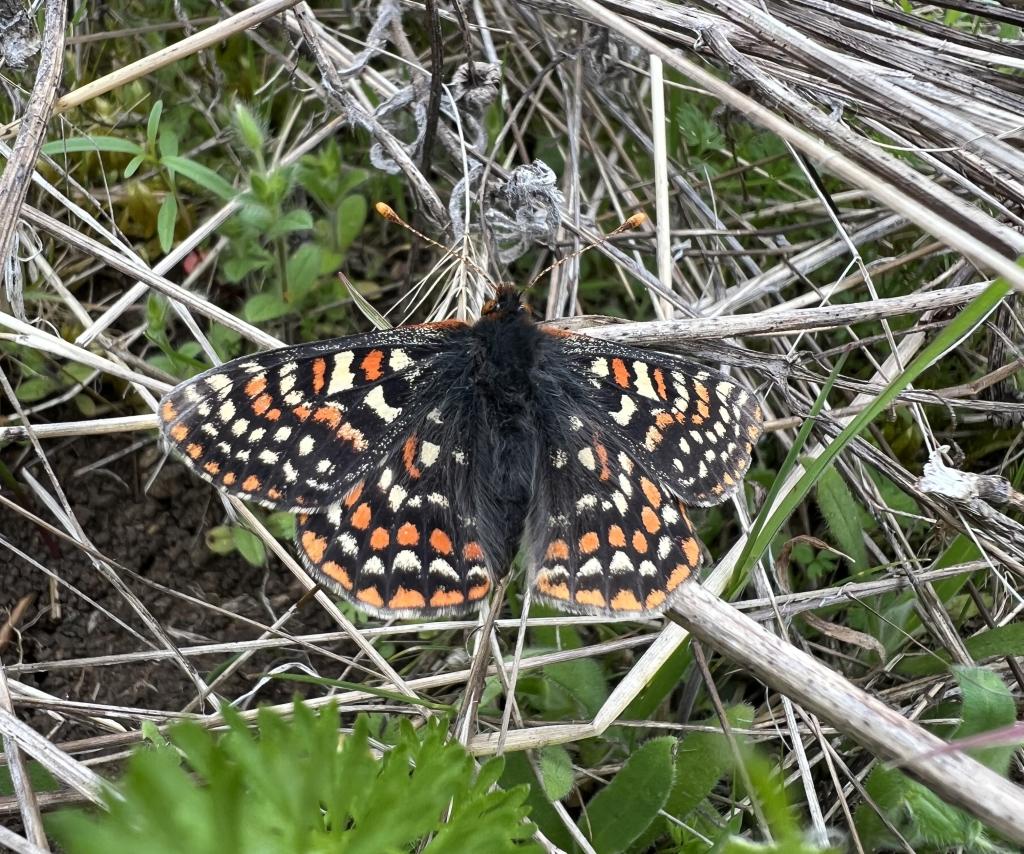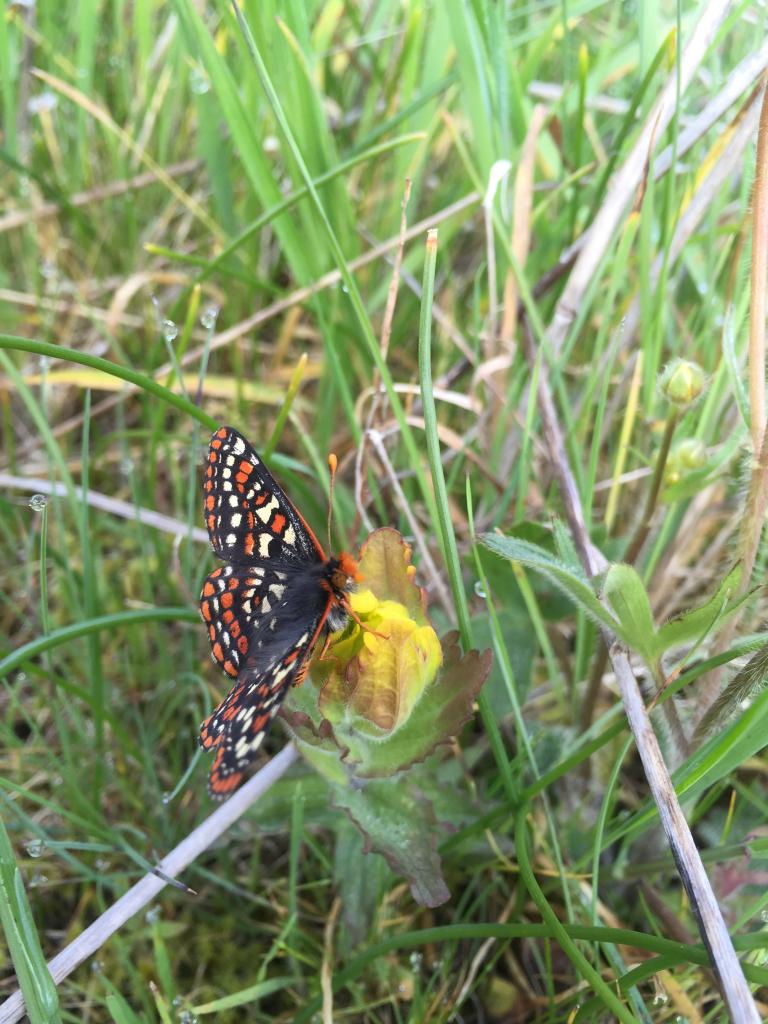By Andrew Esterson, March 2024
Taylor’s checkerspot butterfly, a federally listed endangered species, was once abundant in Pacific Northwest prairies. Currently there are only two extant populations in Oregon, both located in Benton County. The primary threat to Taylor’s checkerspot butterfly is a lack of quality habitat. Invasive perennial grass species create dense layers of vegetation that inhibit the growth of forbs, particularly native nectar species and host plant species. Moreover, the encroachment of conifers and establishment of other woody species reduce the abundance of prairie habitat. In the absence of routine fire, Taylor’s checkerspot butterfly-occupied sites are dependent upon regular maintenance.

In addition, a lack of host plant materials has been a bottleneck for past restoration efforts. Historically, Taylor’s checkerspot butterfly likely used native paintbrush species (Castilleja levisecta and C. hispida) as their primary food source for larvae and young caterpillars, as well as a place for adult butterflies to lay their eggs. Seed from both paintbrush species is not widely available which makes recovery projects challenging. Also, over the past few decades, Taylor’s checkerspot butterfly has largely switched to using the non-native English plantain (Plantago lanceolata) as its primary host, since most native paintbrush have disappeared from their prairie habitat. Although we have been reluctant to use this non-native species in restoration, the state of Taylor’s checkerspot butterfly is dire. We are now compelled to use English plantain—it is good for the butterfly, and we also do not typically see English plantain as being invasive.

Another threat to the butterfly is its small population size and limited population distribution. To address this issue, the U.S Fish and Wildlife Service has funded captive rearing programs at The Oregon Zoo and at the Coffee Creek Correctional Facility (Coffee Creek). Captive-reared larvae are intended to be released at various sites—to help increase population size and expand the distribution of the butterfly.
Currently, Coffee Creek is the only entity in Oregon rearing Taylor’s checkerspot butterfly larvae. However, there is no long-term funding plan for Coffee Creek to continue the program, and there are limitations to rearing at this facility. Captive-rearing and butterfly introductions to native habitat are fundamental to recovering the species and ensuring its survival. Without a robust captive-rearing program, recovery is distant, and extirpation is near. The story of the Taylor’s checkerspot butterfly—thus far—has been has full of doom and gloom.
But, there is hope, and good news to share: in 2023, IAE received funding from the Oregon Watershed and Enhancement Board (OWEB) to fund: (1) habitat restoration efforts, (2) plant material production and acquisition, (3) a new captive rearing center at Oregon State University’s Mid-Columbia Agriculture Research and Extension Center through 2026, and (4) effectiveness monitoring.

Habitat Restoration
The grant provides funding to continue and expand restoration efforts across 130 acres in Benton County, including the two extant sites and seven additional sites for butterfly introduction. Restoration work is well underway: we planted 180 pounds of native nectar seed, 15 pounds of English plantain seed, a small amount of golden paintbrush seed, 6,380 bulbs and 14,600 bare root plants in 2023. In addition, IAE staff treated many acres of invasive weeds including false brome (Brachypodium sylvaticum), Scotch broom (Cytisus scoparius), and Himalayan blackberry (Rubus bifrons). Planting and weed-abatement efforts will continue through 2026.
Seed Production and Plant Material Acquisition
Having plant materials sufficient to regularly put them on the landscape is critical to meeting Taylor’s checkerspot butterfly recovery goals. For butterfly recovery to be successful, we need copious amounts of English plantain, golden and harsh paintbrush, nectar seed, as well as bulbs and bare root plants to be readily available. OWEB funds were used to establish a golden paintbrush seed production field—and over $75,000 of the grant has been earmarked to purchase seed and plugs. Putting these native plants back on the landscape will make a huge difference for the Taylor’s checkerspot butterfly, other native pollinators, and increase biodiversity across the landscape.
Captive Rearing at Oregon State University
We are very excited to partner with Dr. Chris Adams at Oregon State University (OSU) to expand captive-rearing efforts for Taylor’s checkerspot butterfly. Dr. Adams will oversee the program, but day-to-day rearing activities will be led by a Master’s student at OSU: Kelly Asselin. Together, they will work to improve butterfly husbandry methods and annually rear at least 3,000 larvae. Funding from OWEB will allow us to add a second captive rearing program in Oregon—which will double the number of larvae released each year, provide research opportunities related to butterfly husbandry, and provide a crucial bridge to sustain larvae release events, particularly in the event that one lab experiences unexpectedly high larvae mortality.
Maintaining the Coffee Creek program is critically important to captive rearing goals as well. IAE is actively working with the U.S. Fish and Wildlife Service to secure immediate funding for 2024 efforts and we have submitted multiple proposals that will fund the program in 2025 and beyond.
Effectiveness Monitoring
Pre- and post-treatment effectiveness monitoring will be conducted to assess the efficacy of restoration actions at the nine sites included in this project. By monitoring Taylor’s checkerspot habitat conditions and the response of the butterfly to management actions, we will acquire data that can directly inform future restoration efforts and recovery criteria for the butterfly.
We are so excited about this project—and the opportunity to ‘move the needle’ on recovery for Taylor’s checkerspot butterfly in Oregon! This project is unique for IAE in Corvallis—in that all four programs (Conservation Research, Ecological Education, Plant Materials, and Habitat Restoration) are involved in various aspects of the project, and actively collaborating on different aspects of species recovery and habitat restoration. It is a great opportunity for our staff to learn about other programs, develop new skills, and get to know one another a bit better. We are grateful for the opportunity and humbled by the challenges that lie ahead.
None of this work could be done without our amazing partners. We owe tons of thanks to the private landowners who have kindly offered their land for this project, to Greenbelt Land Trust for providing land and endless amounts of knowledge, Benton County for their longstanding commitment to conservation, Dana Ross for his expertise, and to the funders of this project which include OWEB, the U.S. Fish and Wildlife Service and Benton County.
